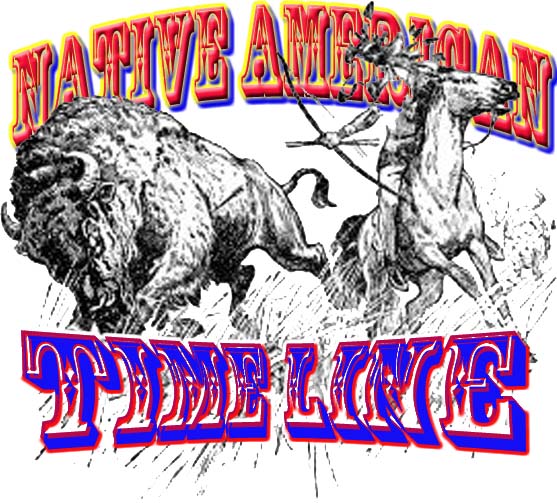1883
After Crow Dog was convicted and sentenced to death of killing fellow Sioux tribe member Spotted Tail, on appeal the Court ruled the prosecution had infringed upon tribal sovereignty, that the U.S. did not have jurisdiction, and Crow Dog must go free.
“The Friends of the Indian” was a assembly of social reforming ministers and government bureaucrats, who through their policies to force Native Americans into the mainstream social order they preferred, almost completely destroyed Native American culture and identity with their history for generations.
After the Lakota Chief Sitting Bull was released form prison he was allowed to rejoin his tribe at Standing Rock and he lived the rest of his life across the Grand River from his place of birth. Against Sitting Bull’s protests promised Indian reservation land was open to white settlers.
Lakota Chief Sitting Bull gave a speech at the Transcontinental Railroad celebration of the driving of the last spike. An army translator told him what to say but in his own language he smiled, periodically bowed, paused for applause, and continued to insult the audience while the translator read the speech he had prepared in advance. The spectators thought he was welcoming and praising them.
The U.S. Supreme Court handed down a ruling that, “an Indian is by birth and alien and such as a dependent of the government.”
1885
William Frederick “Buffalo Bill” Cody was an American army scout, buffalo hunter, and showman and he is quoted saying, “Every Indian outbreak that I have ever known has resulted from the broken promises and broken treaties by the U.S. Government.” He was American’s first entertainment Super Star and he invites Lakota Chief Sitting Bull to go on tour with his Buffalo Bill’s Wild West Show. He was also instrumental in settling the Big Horn Basin of Wyoming.
When Crow Dog was accused of killing Spotted Tail, Crow Dog stated Native Americans were not subject to U.S. laws, “It tries them, not by their peers, nor by the customs of their people, nor the law of their land, but by superiors of a different race, according to the law of a social state of which they have an imperfect conception, and which is opposed to the traditions of their history, to the habits of their lives, to the strongest prejudices of their savage nature; one which measures the red man’s revenge by the maxims of the white man’s morality.” In response Congress passes the Major Crimes Act of 1885 placing seven felony offenses under the jurisdiction of the U.S. Federal Government.
While being chased by U.S. army soldiers a small band of Apache turn the tide of battle forcing the troops into a triple cross-fire trap and the Apache warriors left no one alive.
1886
The US Supreme Court upheld the 1885 Major Crimes Act by overruling a challenge brought by the Hoopa Valley Reservation that Congress did not have a constitutional authority over Indian tribes. The ruling stated that Indian tribes were wards of the US and congress had the right to regulate tribes power over their sovereign tribal lands.
After a decade of guerrilla warfare against American and Mexican settlers in the Southwest, General Nelson A. Miles accepted the surrender of Geronimo, “the most intelligent and resourceful, most vigorous, and farsighted of the Apache leaders” under the terms that Geronimo and his tribe would be re-settled in Florida, with the promise to be able to return some day.
1887
The General Allotment Act gives 160 acres of reservation land to the heads of Indian families and 80 acres to individuals and the land left over from the reservations was open to white settlers.
The commissioner of Indian affairs John DeWitt Clinton Atkins reported that, “tribal languages were not only of no use, but were detrimental to the re-education and civilization of the Indian peoples, and only English would be taught in all Indian schools.
1888
The Oglala Lakota Sioux are moved to the Pine Ridge Agency on the border of South Dakota and Nebraska.
1889
Trying to weaken tribal authority and to make more Indian reservation lands available to white settlers the US Congress passes The Sioux Act dividing the Great Sioux Reservation into six separate reservations.
The Oklahoma Organic Act opened up more Indian reservations for government sponsored land rush for non-Indian settlers. The starting gun sounds at noon, and an estimated 50,000 settlers race across the land; by sunset, all 1.92 million acres have been claimed. Native American tribes are paid about $4 million for the parcel of land.
Charged with, “using witchcraft to chase away rain clouds so white man’s crops would not grow”, two Indians from the Zuni tribe were hanged over the wall of a Spanish church in Arizona.
Washington State opens the Quileute Indian Reservation in the village of La Push at the mouth of the Quillayute River.
For teaching the visionary ceremony foretelling the disappearance of all white people, the “Ghost Dance,” Kicking Bear was removed by force from the standing Rock Agency in South Dakota.
>>to return to previous page – right click on back arrow <<
Word count: 839
























